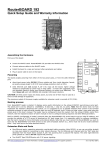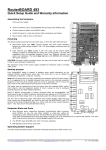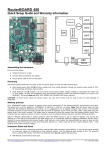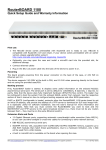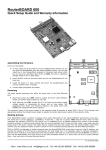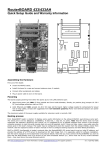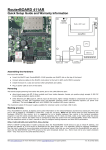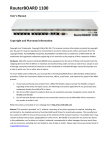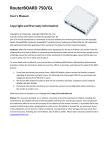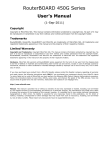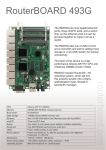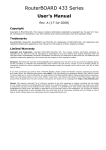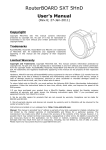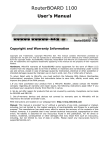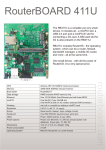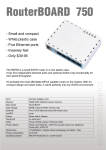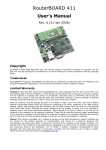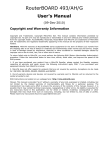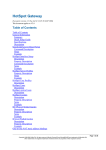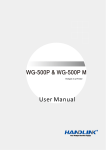Download RouterBOARD 411UAHR Quick Setup Guide and
Transcript
RouterBOARD 411UAHR Quick Setup Guide and Warranty Information Assembling the Hardware First use of the board: ● Optional: Insert a miniPCI card into the miniPCI slot ● Optional: Insert a 3G miniPCI-e card (WLAN cards won't work in this slot) into the miniPCI-e slot, and the Phone's SIM card into the SIM slot. The SIM slot is only used in combination with the miniPCI-e card, it has no function without it. ● Install the board in a case and connect other peripherals (USB) and cables (Ethernet, Antenna cable). ● If using the USB port, you must attach the USB powering cable to the USB port, as the RB411UAHR does not have built in power for USB. USB powered HUB won't work, a special USB power injector is needed. Sold separately. ● Plug in power cable to turn on the board (If not using PoE power over LAN). Please do not power on the device before the antenna cables are connected to avoid possible damage to the wireless card. Powering The board accepts powering from either the power jack or the LAN1 Ethernet port: ● direct-input power jack J7 (5.5mm outside and 2mm inside diameter, female, pin positive plug) accepts 9..28V DC (overvoltage protection starts at 28V). ● LAN1 Ethernet port J8 accepts 9..28V DC input (at the board; higher voltage needed to compensate for power loss on long cables; at least 18V suggested) from non-standard (passive) Power over Ethernet injectors (no power over datalines). The board does not work with IEEE802.3af compliant 48V power injectors. The maximum output of the power supply available for extension cards is normally 10W (3.0A). Booting process First, RouterBOOT is started. It displays some useful information on the onboard RS232C asynchronous serial port. The serial port is set by default to 115200bit/s, 8 data bits, 1 stop bit, no parity . Note that the device does not fully implement the hardware (RTS/CTS) flow control, so it is suggested to try to disable hardware flow control in the terminal emulation program in case the serial console does not work as expected, and if it does not help, make a new cable using the pinout given in the User's manual. The loader may be configured to boot the system from the onboard NAND, and/or from network. See the respective section of User's manual on how to configure booting sequence and other BIOS parameters. http://wiki.mikrotik.com/wiki/First_time_startup DHCP or BOOTP (configurable in loader) protocols allow the RouterBOARD 411U device to get an initial IP address, and provide the address of a TFTP server to download an ELF boot image from. It is especially useful for software installation. See the User's manual for more information and protocol details. Note that you must connect the RouterBOARD you want to boot and the BOOTP/DHCP and TFTP servers to the same broadcast domain (i.e., there must not be any routers between them – they must be on the same Ethernet switch). See www.routerboard.com for more information. Contact [email protected] for support questions. rev. A (7-Jul-2009) Extension Slots and Ports ● One Ethernet port, supporting automatic cross/straight cable correction (Auto MDI/X), so you can use either straight or cross-over cables for connecting to other network devices. The Ethernet port accepts 9..28 V DC powering from a passive PoE injector. ● One miniPCI Type IIIA/IIIB port with 3.3V power signaling. ● One miniPCI-e slot for 3G modem (onboard SIM connector for use exclusively with a miniPCI-e modem plugged in) ● USB 2.0 port without a power supply (external USB power injector is needed, sold separately) ● DB9 RS232C asynchronous serial port. Buttons and Jumpers ● RouterOS reset jumper hole (RESET) – resets RouterOS software to defaults. Must short circuit the metallic sides of the hole (with a screwdriver, for example) and boot the device. Hold screwdriver in place until RouterOS configuration is cleared. ● RouterBOOT reset button (S301) – loads backup RouterBOOT Loader firmware. Must hold button while booting. Use in case operating system can't be booted and no useful information on Serial console output. Operating System Support Currently tested operating system is MikroTik RouterOS (starting from version 3.28). Copyright and Warranty Information Copyright and Trademarks. Copyright MikroTikls SIA. This manual contains information protected by copyright law. No part of it may be reproduced or transmitted in any form without prior written permission from the copyright holder. RouterBOARD, RouterOS, RouterBOOT and MikroTik are trademarks of MikroTikls SIA. All trademarks and registered trademarks appearing in this manual are the property of their respective holders. Hardware. MikroTikls SIA warrants all RouterBOARD series equipment for the term of fifteen (15) months from the shipping date to be free of defects in materials and workmanship under normal use and service, except in case of damage caused by mechanical, electrical or other accidental or intended damages caused by improper use or due to wind, rain, fire or other acts of nature. If you have purchased your product from a MikroTik Reseller, please contact the Reseller company regarding all warranty and repair issues, the following instructions apply ONLY if you purchased your equipment directly from MikroTik Latvia To return failed unit or units to MikroTikls you must perform the following RMA (Return Material Authorization) procedure. Follow the instructions below to save time, efforts, avoid costs, and improve the speed of the RMA process. Take into account that all goods have one year warranty. Instructions are located on our webpage here: http://rma.mikrotik.com Manual. This manual is provided “as is” without a warranty of any kind, expressed or implied, including, but not limited to, the implied warranty of merchantability and fitness for a particular purpose. The manufacturer has made every effort to ensure the accuracy of the contents of this manual, however, it is possible that it may contain technical inaccuracies, typographical or other errors. No liability is assumed for any inaccuracy found in this publication, nor for direct or indirect, incidental, consequential or other damages that may result from such an inaccuracy, including, but not limited to, loss of data or profits. Please report any inaccuracies found to [email protected] See www.routerboard.com for more information. Contact [email protected] for support questions. rev. A (7-Jul-2009)


